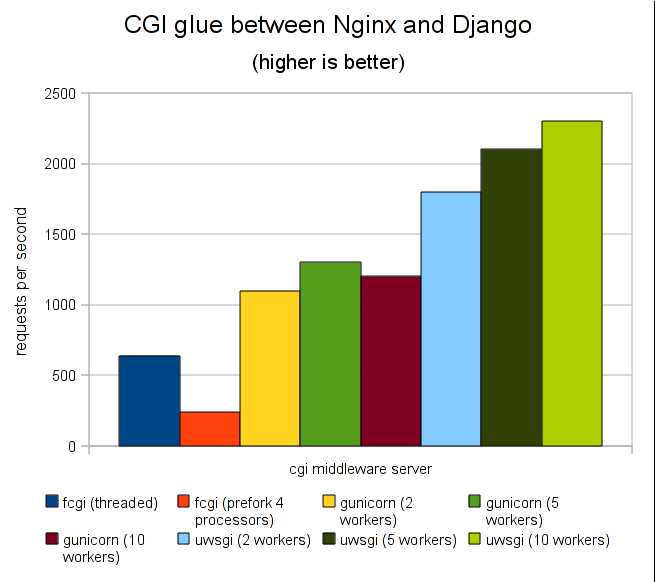标签:影响 代码 cat 常用 reads 命令 starting wsgi 部署
Django的部署可以有很多方式,采用nginx+uwsgi的方式是其中比较常见的一种方式。
uWSGI是一个Web服务器,它实现了WSGI协议、uwsgi、http等协议。Nginx中HttpUwsgiModule的作用是与uWSGI服务器进行交换。
要注意 WSGI / uwsgi / uWSGI 这三个概念的区分。
uwsgi性能非常高

uWSGI的主要特点如下
If you are searching for a simple wsgi-only server, uWSGI is not for you, but if you are building a real (production-ready) app that need to be rock-solid, fast and easy to distribute/optimize for various load-average, you will pathetically and morbidly fall in love (we hope) with uWSGI.
1、准备环境
a、需要linux服务器一台
b、在服务器上面安装好Python和Django
这里安装方法省略。。。。(不懂可以百度解决)
c、uwsgi
# 安装 uwsgi [root@localhost teacher]# pip3 install uwsgi
测试uwsgi
[root@web01 nulige]# cd /home/nulige [root@web01 nulige]# mkdir -p uwsgi_test [root@web01 nulige]# cd uwsgi_test/
#测试文件
[root@web01 uwsgi_test]# vi test.py def application(env, start_response): start_response(‘200 OK‘, [(‘Content-Type‘,‘text/html‘)]) return [b"Hello World"] # python3 #return ["Hello World"] # python2
启动uwsgi
[root@web01 uwsgi_test]# uwsgi --http :8000 --wsgi-file test.py *** Starting uWSGI 2.0.15 (64bit) on [Sat May 27 19:12:58 2017] *** compiled with version: 4.4.7 20120313 (Red Hat 4.4.7-11) on 27 May 2017 18:48:50 os: Linux-2.6.32-504.el6.x86_64 #1 SMP Wed Oct 15 04:27:16 UTC 2014 nodename: web01 machine: x86_64 clock source: unix pcre jit disabled detected number of CPU cores: 1 current working directory: /home/nulige/uwsgi_test detected binary path: /usr/local/python3/bin/uwsgi uWSGI running as root, you can use --uid/--gid/--chroot options *** WARNING: you are running uWSGI as root !!! (use the --uid flag) *** *** WARNING: you are running uWSGI without its master process manager *** your processes number limit is 14719 your memory page size is 4096 bytes detected max file descriptor number: 1024 lock engine: pthread robust mutexes thunder lock: disabled (you can enable it with --thunder-lock) uWSGI http bound on :8000 fd 4 spawned uWSGI http 1 (pid: 17972) uwsgi socket 0 bound to TCP address 127.0.0.1:38831 (port auto-assigned) fd 3 Python version: 3.5.2 (default, May 27 2017, 18:39:42) [GCC 4.4.7 20120313 (Red Hat 4.4.7-11)] *** Python threads support is disabled. You can enable it with --enable-threads *** Python main interpreter initialized at 0x1ed4a90 your server socket listen backlog is limited to 100 connections your mercy for graceful operations on workers is 60 seconds mapped 72768 bytes (71 KB) for 1 cores *** Operational MODE: single process *** WSGI app 0 (mountpoint=‘‘) ready in 0 seconds on interpreter 0x1ed4a90 pid: 17970 (default app) *** uWSGI is running in multiple interpreter mode *** spawned uWSGI worker 1 (and the only) (pid: 17970, cores: 1)
查看启动端口
[root@web01 ~]# ps -ef|grep uwsgi root 17970 1000 0 19:12 pts/0 00:00:00 uwsgi --http :8000 --wsgi-file test.py root 17972 17970 0 19:12 pts/0 00:00:00 uwsgi --http :8000 --wsgi-file test.py root 17996 17973 0 19:14 pts/1 00:00:00 grep uwsgi
根据项目进行配置
# 启动 uwsgi **进入项目目录** **使用uwsgi启动前确保无代码问题导致通过runserver可以正常启动起来** uwsgi --http 192.168.31.123:8080 --file teacher/wsgi.py --static-map=/static=static #测试启动 # 解释 --http 这个就和runserver一样指定IP 端口 --file 这个文件就里有一个反射,如果你在调用他的时候没有指定Web Server就使用默认的 -- static 做一个映射,指定静态文件
2、生产环境配置
Nginx + uWSGI + Djangos配置方法:
# uwsig使用配置文件启动 [uwsgi] # 项目目录 chdir=/opt/project_teacher/teacher/ # 指定项目的application module=teacher.wsgi:application # 指定sock的文件路径 socket=/opt/project_teacher/script/uwsgi.sock # 进程个数 workers=5 pidfile=/opt/project_teacher/script/uwsgi.pid # 指定IP端口 http=192.168.31.123:8080 # 指定静态文件 static-map=/static=/opt/test_project/teacher/static # 启动uwsgi的用户名和用户组 uid=root gid=root # 启用主进程 master=true # 自动移除unix Socket和pid文件当服务停止的时候 vacuum=true # 序列化接受的内容,如果可能的话 thunder-lock=true # 启用线程 enable-threads=true # 设置自中断时间 harakiri=30 # 设置缓冲 post-buffering=4096 # 设置日志目录 daemonize=/opt/project_teacher/script/uwsgi.log
# uwsig常用命令
# 通过配置文件启动 uwsgi --ini uwsgi.ini # 会生成两个文件 PID文件 他是标识这个程序所处的状态 SOCK文件 他是用来和其他程序通信的 # 停止uwsgi uwsgi --stop uwsgi.pid # 重载配置 uwsgi --reload uwsgi.ini
d、nginx
#先换成国内yum源
#以CentOS6.x 系统为例 1、备份 mv /etc/yum.repos.d/CentOS-Base.repo /etc/yum.repos.d/CentOS-Base.repo.backup 2、更换成国内源 wget -O /etc/yum.repos.d/CentOS-Base.repo http://mirrors.aliyun.com/repo/Centos-6.repo 3、之后运行yum makecache生成缓存
# 安装nginx
yum -y install nginx
# Nginx添加配置文件
#先进入到配置文件:
vi /etc/nginx/conf.d/ #编辑配置文件 server { # 这个server标识我要配置了 listen 80; # 我要监听那个端口 server_name 10.129.205.183 ; # 你访问的路径前面的url名称 access_log /var/log/nginx/access.log main; # Nginx日志配置 charset utf-8; # Nginx编码 gzip on; # 启用压缩,这个的作用就是给用户一个网页,比如3M压缩后1M这样传输速度就会提高很多 gzip_types text/plain application/x-javascript text/css text/javascript application/x-httpd-php application/json text/json image/jpeg image/gif image/png application/octet-stream; # 支持压缩的类型 error_page 404 /404.html; # 错误页面 error_page 500 502 503 504 /50x.html; # 错误页面 # 指定项目路径uwsgi location / { # 这个location就和咱们Django的url(r‘^admin/‘, admin.site.urls), include uwsgi_params; # 导入一个Nginx模块他是用来和uWSGI进行通讯的 uwsgi_connect_timeout 30; # 设置连接uWSGI超时时间 uwsgi_pass unix:/opt/project_teacher/script/uwsgi.sock; # 指定uwsgi的sock文件所有动态请求就会直接丢给他 } # 指定静态文件路径 location /static/ { alias /opt/project_teacher/teacher/static/; index index.html index.htm; } }
# 启动Nginx通过Nginx访问
/etc/init.d/nginx start /etc/init.d/nginx stop # 这里有个命令configtest,Nginx配置是重启生效的,如果你修改完了,不知道对不对又担心影响其他人可以使用它测试 /etc/init.d/nginx configtest # 如果是生产环境的话Nginx正在运行,就不要直接stop start 或者 restart 直接reload就行了 # 对线上影响最低(生产环境用的方法) /etc/init.d/nginx reload
e、Django Admin静态文件配置
有一个小bug:
# 解决Django静态配置文件丢失
问题原因: 是因为admin所需的js,css等静态文件都在django的安装目录内,但是我们并没有配置指向Django的配置文件。 解决办法: 我们可以通过配置 STATIC_ROOT = os.path.join(BASE_DIR, "static_all")来指定静态文件的默认家目录是那里,然后把项目里所有的静态文件都收集起来放到这个目录下面。 收集命令: python3 manage.py collectstatic --noinput 修改Nginx 指定静态路径 alias /opt/test_project/teacher/static_all/;
Django + Uwsgi + Nginx 实现生产环境部署
标签:影响 代码 cat 常用 reads 命令 starting wsgi 部署
原文地址:http://www.cnblogs.com/nulige/p/6914214.html